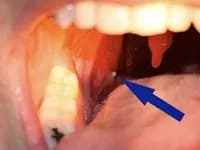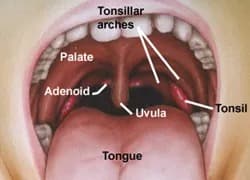Tonsil Stones: Causes, Treatment, and Prevention
If you have bad breath (halitosis) and the uncontrollable urge to clear your throat, you may have tonsil stones (also called tonsilloliths). Tonsil stones are not a sign of poor hygiene or poor oral health practices. Tonsil stones are hardened white or yellow globules that form inside pockets/crevices (crypts) on the surface of the tonsils, located in the back of the mouth directly behind your lower molars or wisdom teeth. Occasionally, these calcified deposits accumulate on the roof of the mouth and in the back of the throat, although they are more typically found in the tonsils.
Bacteria is the Root Cause
 As you eat, food moves past the tonsils and down your throat. Typically, a little food residue sticks to the walls of the throat, albeit temporarily. However, tonsils have crevices which can trap little bits of food long enough for bacteria to grow. Oral microbes digest, burrow into, and even live on top of food particles. This layer of microorganisms, called biofilm, is responsible for the foul smell of bad breath. The biofilm attracts more food particles, which generates more bacteria, and so forth. Tonsil stones do not appear suddenly, but grow gradually in the crevices, in much the same way as pearls form inside oysters. Because tonsil stones develop within these pockets, they are often not discovered until a patient has dental x-rays.
As you eat, food moves past the tonsils and down your throat. Typically, a little food residue sticks to the walls of the throat, albeit temporarily. However, tonsils have crevices which can trap little bits of food long enough for bacteria to grow. Oral microbes digest, burrow into, and even live on top of food particles. This layer of microorganisms, called biofilm, is responsible for the foul smell of bad breath. The biofilm attracts more food particles, which generates more bacteria, and so forth. Tonsil stones do not appear suddenly, but grow gradually in the crevices, in much the same way as pearls form inside oysters. Because tonsil stones develop within these pockets, they are often not discovered until a patient has dental x-rays.
Some experts believe that in specific cases, the location of tonsil stones plays a more important role than unchecked mouth debris. For example, when they are located around the tonsils in the peritonsillar area, this leads to tissue growth in abnormal areas (ectopic tissue) and calcifications.
As a result of sitting undisturbed within these almost microscopic pockets, the debris hardens and calcifies into tiny white or yellow stone-like pieces. Tonsil stones contain magnesium and calcium salts such as oxalates, ammonium radicals, and hydroxyapatite. The stones are usually no bigger than two millimeters in thickness and often cause extremely bad breath as the primary symptom.
The Role and Function of the Tonsils
 In prehistoric times, tonsils performed vital immunological functions, filtering out various harmful viruses and bacteria from the air before they reached the lungs. Evolution has led to modern-day tonsils that are inundated with 20 times more germs and far more diverse bacteria than what existed in our prehistoric ancestors.
In prehistoric times, tonsils performed vital immunological functions, filtering out various harmful viruses and bacteria from the air before they reached the lungs. Evolution has led to modern-day tonsils that are inundated with 20 times more germs and far more diverse bacteria than what existed in our prehistoric ancestors.
As a result, many individuals who still have tonsils frequently experience inflamed tonsils or tonsillitis and the inability to cope with a multitude of bacteria and viruses infecting the air. When tonsils are swollen, the adenoids are also frequently swollen. Adenoids or pharyngeal tonsils are located in the area between the throat and the back of the nose and filter out bacteria in much the same way as tonsils. Tonsil-related illnesses are a common underlying cause of tonsil stone formation.
Tonsillitis Symptoms
- Bright red, inflamed tonsils or tonsils coated with a yellowish film
- Sore throat
- Swollen lymph nodes
- Fever and earache
- Bad breath (halitosis)
In addition to chronic tonsillitis, a proliferation of bacteria and tonsil stones can be caused by other health conditions and compounding factors. The following likely play a role in their formation:
- Overactive salivary glands
- Sinus and bacterial infections
- Postnasal drip
- Allergies
- Viruses
- Excessive accumulation of dead leukocytes (white blood cells)
- The action of enzymes on food that is trapped in the mouth
- Medication-related dry mouth
- Certain dietary and lifestyle factors (e.g. alcohol use, too much refined food, stress)
- Genetic factors such as the size, shape, and depth of the tonsil pockets/crevices
Why do Tonsil Stones Cause Bad Breath?
Tonsil stones cause bad breath because anaerobic bacteria flourish in low-oxygen conditions, such as the environment found in and around tonsil crevices. Anaerobic bacteria continuously excrete potent amounts of substances that smell like rotting eggs. Individuals suffering from tonsil stones are especially aware of this odor when a tonsil stone disintegrates, is dislodged, or inadvertently chewed.
If a person has dry mouth, this makes the situation worse because without adequate saliva, which contains oxygen and antibacterial qualities, the bacteria grow unchecked. Lack of sufficient saliva combined with food and mucous debris directly contributes to tonsil stone formation and bad breath.
Watch Dr. Katz Discuss Tonsil Stones and Their Treatment
Understanding what causes tonsil stones helps highlight the importance of maintaining good oral hygiene. That means brushing twice a day and keeping the mouth as hydrated as possible to reduce the presence of excessive anaerobic bacteria. Tonsil stones tend to recur, so it is helpful to avoid alcohol and refined foods as much as possible once you’ve had them.
TheraBreath offers a wide array of products that help prevent the formation of tonsils stones and bad breath. The Tonsil Stones Treatment Kit or Tonsil Stones Deluxe Kit contain everything you need in one handy kit.
* Statements on this page have not been evaluated by the Food and Drug Administration. These products are not intended to diagnose, treat, cure, or prevent any disease. The material on this site is provided for informational purposes only. Always consult your healthcare professional before beginning any new therapy.
